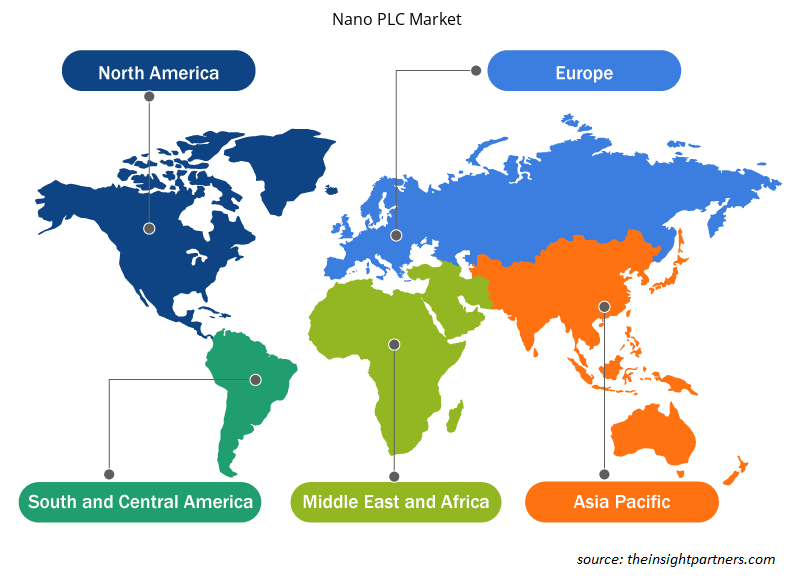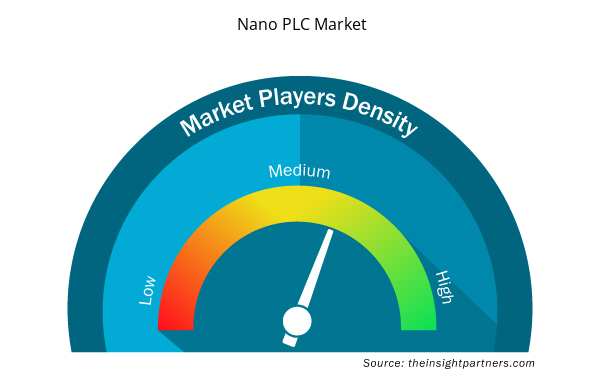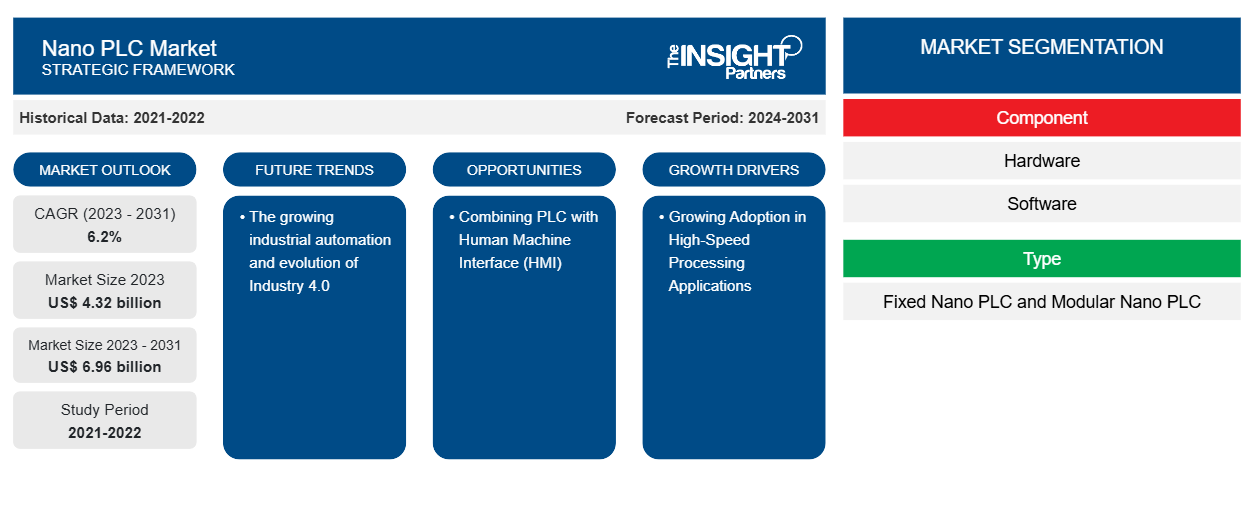Der Markt für Nano-SPS soll von 4,32 Milliarden US-Dollar im Jahr 2023 auf 6,96 Milliarden US-Dollar im Jahr 2031 anwachsen. Der Markt soll zwischen 2023 und 2031 eine durchschnittliche jährliche Wachstumsrate (CAGR) von 6,2 % verzeichnen. Die zunehmende industrielle Automatisierung und die Entwicklung von Industrie 4.0 werden voraussichtlich weiterhin wichtige Trends auf dem Markt für Nano-SPS bleiben.
Nano PLC Marktanalyse
Der Nano-SPS-Markt wächst rasant aufgrund der zunehmenden Verbreitung von Hochgeschwindigkeitsverarbeitungsanwendungen, der schnellen Industrialisierung und der zunehmenden Nutzung automatischer Sicherheitssysteme. Der Markt wächst stetig, angetrieben von der wachsenden Nachfrage nach intelligenter Fertigung. Darüber hinaus bieten die Kombination von SPS mit Mensch-Maschine-Schnittstellen (HMI) und die zunehmende Verbreitung technologisch fortschrittlicher Lösungen wie IoT-Beleuchtung lukrative Möglichkeiten für Marktwachstum.
Nano PLC Marktübersicht
Nano-SPS sind Steuergeräte, die industrielle Steuerungssysteme verbessern, indem sie die Anpassungsfähigkeit verbessern und die Komplexität verringern. Nano-SPS können industrielle Prozesse verbessern und optimieren, was ihre Akzeptanz in der Industrie erhöht. In den heutigen Industrieumgebungen entwickeln sich die Wettbewerbs- und Technologielandschaften rasant. Die Nachfrage nach großer industrieller Automatisierung hat die Akzeptanz von Nano-SPS zur Ausführung von Aufgaben durch Verbesserung der Produktivität und Kosteneinsparungen angekurbelt. Darüber hinaus beflügelt die wachsende Nachfrage nach flexiblen Automatisierungslösungen in der Industrie den Markt im Prognosezeitraum.
Passen Sie diesen Bericht Ihren Anforderungen an
Sie erhalten kostenlos individuelle Anpassungen an jedem Bericht, einschließlich Teilen dieses Berichts oder einer Analyse auf Länderebene, eines Excel-Datenpakets sowie tolle Angebote und Rabatte für Start-ups und Universitäten.
- Holen Sie sich die wichtigsten Markttrends aus diesem Bericht.Dieses KOSTENLOSE Beispiel umfasst eine Datenanalyse von Markttrends bis hin zu Schätzungen und Prognosen.
Treiber und Chancen auf dem Nano-SPS-Markt
Zunehmende Nutzung von Hochgeschwindigkeitsverarbeitungsanwendungen treibt den Markt an
Nano-SPS sind sehr kompakte Lösungen mit Standardfunktionen, die einfach einzurichten sind. Die kompakte Größe von Nano-SPS erhöht ihre Akzeptanz bei Hochgeschwindigkeitsverarbeitungsanwendungen und Steuerungssystemen, die Zählkapazität oder kurze Reaktionszeiten erfordern. Nano-SPS sind in der Lage, mit verschiedenen Arten von kurzen Reaktionszeiten zu arbeiten, darunter schnelle Zähler (maximale Frequenz 10 kHz), schnelle Aufwärts-/Abwärtszähler (maximale Frequenz 1 kHz) und Frequenzmesser (maximale Frequenz 10 kHz). Darüber hinaus bieten Nano-SPS für Hochgeschwindigkeitsanwendungen erhebliche Vorteile wie die Verfügbarkeit von Batterie-Backups, PID-Schleifen für Steuerungssystemanwendungen , unbegrenzten schreibgeschützten Speicher und einen kostengünstigen Ersatz für herkömmliche Lösungen. Nano-SPS bietet jedoch Flexibilität durch einfache Steuerung und Handhabung komplexer Verarbeitungsanwendungen, was den Markt im Prognosezeitraum ankurbelt.
Kombination von SPS mit Mensch-Maschine-Schnittstelle (HMI) – eine Chance auf dem Nano-SPS-MarktPLC with Human Machine Interface (HMI) - An Opportunity in the Nano PLC Market
Die heutigen HMIs sind in der Lage, viele der Funktionen auszuführen, die früher von Steuerungssystemen ausgeführt und gehandhabt wurden, einschließlich der eigentlichen Maschinensteuerung und der E/A-Verarbeitung von Sensoren und Maschinen. Die Vermischung der Funktionen hat zur Entwicklung von HMI-SPS-Kombieinheiten geführt. Die Kombination ist eine natürliche Erweiterung eines anhaltenden Trends, da SPSen über eine Art Basisschnittstelle verfügen und HMIs sich zunehmend weiterentwickelt haben, um grundlegendere Steuerungsfunktionen bereitzustellen. Die Kombination von HMI-SPS-Einheiten vereint industriell gehärtete Geräte in einem einzigen Gehäuse. Diese Kombination fungiert als Webserver und bietet den Benutzern in der Regel erhebliche Vorteile beim Einstellen von Alarmen, Erstellen von Diagrammen, Aufzeichnen von Daten und Überwachen von Trends mit mehreren Steuerungsfunktionen, was ihre Akzeptanz in den Branchen erhöht. HMI-SPS-Einheiten unterstützen Branchen bei der Reduzierung der Betriebskomplexität und verkürzen die Entwicklungszeit durch Senkung der Gesamtbetriebskosten und werden im Prognosezeitraum voraussichtlich Marktchancen schaffen.
Segmentierungsanalyse des Nano PLC-Marktberichts
Wichtige Segmente, die zur Ableitung der Nano-SPS-Marktanalyse beigetragen haben, sind Komponente, Typ und Branche.
- Basierend auf den Komponenten ist der Nano-SPS-Markt in Hardware und Software unterteilt. Das Hardwaresegment ist weiter unterteilt in Prozessor, Stromversorgung, Eingabe/Ausgabe (I/O) und andere Hardware. Das Hardwaresegment hatte im Jahr 2023 einen größeren Marktanteil.
- Auf der Grundlage des Typs ist der Nano-SPS-Markt in feste Nano-SPS und modulare Nano-SPS unterteilt. Das Segment der festen Nano-SPS hatte im Jahr 2023 einen größeren Marktanteil.
- In Bezug auf die Branchen wird der Nano-SPS-Markt in die Branchen Automobil, Energie und Strom, Haus- und Gebäudeautomation, Öl und Gas, Pharmazeutika, Metalle und Bergbau sowie andere Branchen eingeteilt. Das Automobilsegment hatte im Jahr 2023 einen größeren Marktanteil.
Nano PLC Marktanteilsanalyse nach Geografie
Der geografische Umfang des Nano-SPS-Marktberichts ist hauptsächlich in fünf Regionen unterteilt: Nordamerika, Asien-Pazifik, Europa, Naher Osten und Afrika sowie Südamerika/Süd- und Mittelamerika.
In Bezug auf den Umsatz hatte der nordamerikanische Markt aufgrund der zunehmenden Automatisierung und der hohen Verbreitung technologisch fortschrittlicher Produkte den größten Marktanteil im Bereich Nano-SPS. Der zunehmende Fokus auf Forschungsaktivitäten zur Entwicklung hochwertiger Nano-SPS schafft Chancen auf dem Markt.
Der Markt im asiatisch-pazifischen Raum wird im Prognosezeitraum voraussichtlich wachsen, da zahlreiche Branchen wie Automobil, Energie und Strom, Öl und Gas und andere expandieren. Diese Branchen nutzen Nano-SPS zur Einführung intelligenter Fertigungsprozesse und treiben den Markt an. Darüber hinaus kurbeln zunehmende staatliche Initiativen zur Förderung von Automatisierungsprojekten und die wachsende Zahl von Infrastrukturentwicklungsaktivitäten den Markt im asiatisch-pazifischen Raum an.
Regionale Einblicke in den Nano-SPS-Markt
Die regionalen Trends und Faktoren, die den Nano-SPS-Markt im Prognosezeitraum beeinflussen, wurden von den Analysten von Insight Partners ausführlich erläutert. In diesem Abschnitt werden auch die Marktsegmente und die Geografie von Nano-SPS in Nordamerika, Europa, im asiatisch-pazifischen Raum, im Nahen Osten und Afrika sowie in Süd- und Mittelamerika erörtert.

- Holen Sie sich regionale Daten zum Nano-SPS-Markt
Umfang des Nano PLC-Marktberichts
| Berichtsattribut | Details |
|---|---|
| Marktgröße im Jahr 2023 | 4,32 Milliarden US-Dollar |
| Marktgröße bis 2031 | 6,96 Milliarden US-Dollar |
| Globale CAGR (2023 - 2031) | 6,2 % |
| Historische Daten | 2021-2022 |
| Prognosezeitraum | 2024–2031 |
| Abgedeckte Segmente | Nach Komponente
|
| Abgedeckte Regionen und Länder | Nordamerika
|
| Marktführer und wichtige Unternehmensprofile |
|
Marktteilnehmerdichte: Der Einfluss auf die Geschäftsdynamik
Der Markt für Nano-SPS wächst rasant, angetrieben durch die steigende Nachfrage der Endnutzer aufgrund von Faktoren wie sich entwickelnden Verbraucherpräferenzen, technologischen Fortschritten und einem größeren Bewusstsein für die Vorteile des Produkts. Mit steigender Nachfrage erweitern Unternehmen ihr Angebot, entwickeln Innovationen, um die Bedürfnisse der Verbraucher zu erfüllen, und nutzen neue Trends, was das Marktwachstum weiter ankurbelt.
Die Marktteilnehmerdichte bezieht sich auf die Verteilung von Firmen oder Unternehmen, die in einem bestimmten Markt oder einer bestimmten Branche tätig sind. Sie gibt an, wie viele Wettbewerber (Marktteilnehmer) in einem bestimmten Marktraum im Verhältnis zu seiner Größe oder seinem gesamten Marktwert präsent sind.
Die wichtigsten auf dem Nano-SPS-Markt tätigen Unternehmen sind:
- Crouzet Automatismes SAS
- Emerson Electric Co.
- EZAutomation
- Keyence Corporation
- Mitsubishi Electric Corporation
- OMRON Corporation
Haftungsausschluss : Die oben aufgeführten Unternehmen sind nicht in einer bestimmten Reihenfolge aufgeführt.

- Überblick über die wichtigsten Akteure auf dem Nano-SPS-Markt
Neuigkeiten und aktuelle Entwicklungen zum Nano-SPS-Markt
Der Nano-PLC-Markt wird durch die Erhebung qualitativer und quantitativer Daten nach Primär- und Sekundärforschung bewertet, die wichtige Unternehmensveröffentlichungen, Verbandsdaten und Datenbanken umfasst. Im Folgenden finden Sie eine Liste der Entwicklungen auf dem Markt für Nano-PLC und Strategien:
- Im April 2024 entschied sich das französische Unternehmen Crouzet für den Aerospace and Defence Park in Bangalore, um dort seine neue Fabrik zur Herstellung mechatronischer Komponenten für den indischen und internationalen Markt zu errichten. (Quelle: Französische Botschaft in Indien, Pressemitteilung, 2024)
Marktbericht zu Nano-SPS – Abdeckung und Ergebnisse
Der Bericht „Marktgröße und Prognose für Nano-SPS (2021–2031)“ bietet eine detaillierte Analyse des Marktes, die die folgenden Bereiche abdeckt:
- Marktgröße und Prognose auf globaler, regionaler und Länderebene für alle wichtigen Marktsegmente, die im Rahmen des Projekts abgedeckt sind
- Marktdynamik wie Treiber, Beschränkungen und wichtige Chancen
- Wichtige Zukunftstrends
- Detaillierte PEST/Porters Five Forces- und SWOT-Analyse
- Globale und regionale Marktanalyse mit wichtigen Markttrends, wichtigen Akteuren, Vorschriften und aktuellen Marktentwicklungen
- Branchenlandschaft und Wettbewerbsanalyse, einschließlich Marktkonzentration, Heatmap-Analyse, prominenten Akteuren und aktuellen Entwicklungen
- Detaillierte Firmenprofile
- Historische Analyse (2 Jahre), Basisjahr, Prognose (7 Jahre) mit CAGR
- PEST- und SWOT-Analyse
- Marktgröße Wert/Volumen – Global, Regional, Land
- Branche und Wettbewerbsumfeld
- Excel-Datensatz


- Cosmetic Bioactive Ingredients Market
- Equipment Rental Software Market
- Clear Aligners Market
- Portable Power Station Market
- Energy Recovery Ventilator Market
- Integrated Platform Management System Market
- Social Employee Recognition System Market
- Electronic Toll Collection System Market
- Influenza Vaccines Market
- Digital Pathology Market

Report Coverage
Revenue forecast, Company Analysis, Industry landscape, Growth factors, and Trends

Segment Covered
This text is related
to segments covered.

Regional Scope
North America, Europe, Asia Pacific, Middle East & Africa, South & Central America

Country Scope
This text is related
to country scope.
Häufig gestellte Fragen
The global nano PLC market was estimated to be US$ 4.32 billion in 2023 and is expected to grow at a CAGR of 6.2% during the forecast period 2023 - 2031.
The growing adoption of high-speed processing applications, rapid industrialization, and increasing usage of automatic security systems are the major factors that propel the global nano PLC market.
The growing industrial automation and evolution of Industry 4.0 to play a significant role in the global nano PLC market in the coming years.
The key players holding majority shares in the global nano PLC market are Crouzet Automatismes SAS, Emerson Electric Co., EZAutomation, Keyence Corporation, and Mitsubishi Electric Corporation.
The global nano PLC market is expected to reach US$ 6.96 billion by 2031.
The incremental growth expected to be recorded for the global nano PLC market during the forecast period is US$ 2.65 billion.
Trends and growth analysis reports related to Electronics and Semiconductor : READ MORE..
The Insight Partners performs research in 4 major stages: Data Collection & Secondary Research, Primary Research, Data Analysis and Data Triangulation & Final Review.
- Data Collection and Secondary Research:
As a market research and consulting firm operating from a decade, we have published and advised several client across the globe. First step for any study will start with an assessment of currently available data and insights from existing reports. Further, historical and current market information is collected from Investor Presentations, Annual Reports, SEC Filings, etc., and other information related to company’s performance and market positioning are gathered from Paid Databases (Factiva, Hoovers, and Reuters) and various other publications available in public domain.
Several associations trade associates, technical forums, institutes, societies and organization are accessed to gain technical as well as market related insights through their publications such as research papers, blogs and press releases related to the studies are referred to get cues about the market. Further, white papers, journals, magazines, and other news articles published in last 3 years are scrutinized and analyzed to understand the current market trends.
- Primary Research:
The primarily interview analysis comprise of data obtained from industry participants interview and answers to survey questions gathered by in-house primary team.
For primary research, interviews are conducted with industry experts/CEOs/Marketing Managers/VPs/Subject Matter Experts from both demand and supply side to get a 360-degree view of the market. The primary team conducts several interviews based on the complexity of the markets to understand the various market trends and dynamics which makes research more credible and precise.
A typical research interview fulfils the following functions:
- Provides first-hand information on the market size, market trends, growth trends, competitive landscape, and outlook
- Validates and strengthens in-house secondary research findings
- Develops the analysis team’s expertise and market understanding
Primary research involves email interactions and telephone interviews for each market, category, segment, and sub-segment across geographies. The participants who typically take part in such a process include, but are not limited to:
- Industry participants: VPs, business development managers, market intelligence managers and national sales managers
- Outside experts: Valuation experts, research analysts and key opinion leaders specializing in the electronics and semiconductor industry.
Below is the breakup of our primary respondents by company, designation, and region:

Once we receive the confirmation from primary research sources or primary respondents, we finalize the base year market estimation and forecast the data as per the macroeconomic and microeconomic factors assessed during data collection.
- Data Analysis:
Once data is validated through both secondary as well as primary respondents, we finalize the market estimations by hypothesis formulation and factor analysis at regional and country level.
- Macro-Economic Factor Analysis:
We analyse macroeconomic indicators such the gross domestic product (GDP), increase in the demand for goods and services across industries, technological advancement, regional economic growth, governmental policies, the influence of COVID-19, PEST analysis, and other aspects. This analysis aids in setting benchmarks for various nations/regions and approximating market splits. Additionally, the general trend of the aforementioned components aid in determining the market's development possibilities.
- Country Level Data:
Various factors that are especially aligned to the country are taken into account to determine the market size for a certain area and country, including the presence of vendors, such as headquarters and offices, the country's GDP, demand patterns, and industry growth. To comprehend the market dynamics for the nation, a number of growth variables, inhibitors, application areas, and current market trends are researched. The aforementioned elements aid in determining the country's overall market's growth potential.
- Company Profile:
The “Table of Contents” is formulated by listing and analyzing more than 25 - 30 companies operating in the market ecosystem across geographies. However, we profile only 10 companies as a standard practice in our syndicate reports. These 10 companies comprise leading, emerging, and regional players. Nonetheless, our analysis is not restricted to the 10 listed companies, we also analyze other companies present in the market to develop a holistic view and understand the prevailing trends. The “Company Profiles” section in the report covers key facts, business description, products & services, financial information, SWOT analysis, and key developments. The financial information presented is extracted from the annual reports and official documents of the publicly listed companies. Upon collecting the information for the sections of respective companies, we verify them via various primary sources and then compile the data in respective company profiles. The company level information helps us in deriving the base number as well as in forecasting the market size.
- Developing Base Number:
Aggregation of sales statistics (2020-2022) and macro-economic factor, and other secondary and primary research insights are utilized to arrive at base number and related market shares for 2022. The data gaps are identified in this step and relevant market data is analyzed, collected from paid primary interviews or databases. On finalizing the base year market size, forecasts are developed on the basis of macro-economic, industry and market growth factors and company level analysis.
- Data Triangulation and Final Review:
The market findings and base year market size calculations are validated from supply as well as demand side. Demand side validations are based on macro-economic factor analysis and benchmarks for respective regions and countries. In case of supply side validations, revenues of major companies are estimated (in case not available) based on industry benchmark, approximate number of employees, product portfolio, and primary interviews revenues are gathered. Further revenue from target product/service segment is assessed to avoid overshooting of market statistics. In case of heavy deviations between supply and demand side values, all thes steps are repeated to achieve synchronization.
We follow an iterative model, wherein we share our research findings with Subject Matter Experts (SME’s) and Key Opinion Leaders (KOLs) until consensus view of the market is not formulated – this model negates any drastic deviation in the opinions of experts. Only validated and universally acceptable research findings are quoted in our reports.
We have important check points that we use to validate our research findings – which we call – data triangulation, where we validate the information, we generate from secondary sources with primary interviews and then we re-validate with our internal data bases and Subject matter experts. This comprehensive model enables us to deliver high quality, reliable data in shortest possible time.


 Holen Sie sich ein kostenloses Muster für diesen Bericht
Holen Sie sich ein kostenloses Muster für diesen Bericht